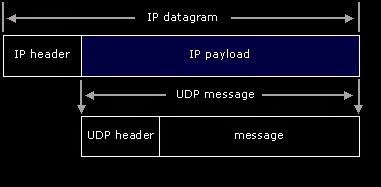User Data-gram Protocol (UDP):
User Datagram Protocol provides a connection-less datagram service that offers best-effort delivery, which means that UDP does not guarantee delivery or verify sequencing for any datagrams.
A source host that needs reliable communication must use either TCP or a program that provides its own sequencing and acknowledgement services. The user datagram protocol is the most important protocol of the TCP/IP suite and is used to send short messages known as data-gram.
Common network applications that use UDP are DNS, online games, IPTV, TFTP and VOIP. UDP is very fast and lightweight. UDP is an unreliable connection-less protocol that operates on the transport layer and it is sometimes called Universal Datagram Protocol.
UDP messages are encapsulated and sent within IP datagrams, as shown in the following illustration.

UDP operates by transmitting datagrams between devices, with each datagram being a self-contained unit of data that contains a header and a payload. The header includes information such as the source and destination ports, the length of the datagram, and a checksum for error detection. The payload contains the actual data being transmitted.
Because UDP does not provide reliability or congestion control, applications that use UDP must implement their own mechanisms for these functions, if required.






![[Top 10] Best ways to Earn Money Online 2023 popular ways to earn online money](https://bytizenotes.com/wp-content/uploads/2023/02/make-money-online-100x70.png)